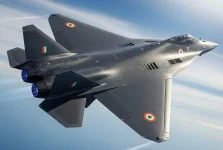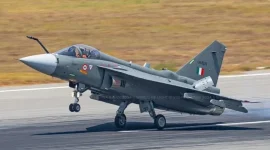- Views: 1K
- Replies: 2
United States Vice President JD Vance has strongly advocated for India acquiring advanced F-35A stealth fighter jets during his ongoing official visit.
Speaking in Jaipur, Mr. Vance highlighted the aircraft's potential, stating, “American F-35s will give the Indian Air Force the ability to defend airspace and protect your people.”
This emphasis on the high-tech fighter comes during a four-day trip (April 21-24, 2025) aimed at significantly strengthening the strategic partnership between the two nations.
Mr. Vance is accompanied by his wife Usha Vance, their children, and a senior American delegation for meetings with top Indian officials, including Prime Minister Narendra Modi and National Security Adviser Ajit Doval.
The potential offer of the Lockheed Martin F-35A Lightning II, a fifth-generation fighter known for its stealth, advanced sensors, and network capabilities, has become a central topic. This follows discussions between President Donald Trump and PM Modi in February 2025, where the F-35A was reportedly considered alongside other significant defence platforms.
Equipping India with the F-35A would place it among an exclusive group of operators, including its Quad partners – the US, Japan, and Australia. American sources suggest a primary motivation for offering the jet is to enhance military compatibility among Quad members, thereby strengthening their collective capacity to address strategic challenges in the Indo-Pacific region, particularly concerning China's advanced J-20 and J-35 fighters.
Mr. Vance's visit, covering Delhi, Jaipur, and Agra, mixes diplomatic talks with trade discussions and cultural activities. A key outcome was the launch of the India-US COMPACT (Catalyzing Opportunities for Military Partnership, Accelerated Commerce & Technology) initiative during a meeting between Mr. Vance and PM Modi on April 21.
According to the Prime Minister's Office, both leaders acknowledged substantial progress in trade talks and discussed deeper collaboration in defence, energy, and strategic technology sectors.
The US continues to encourage India to acquire other American defence systems, including more P-8I Neptune maritime surveillance aircraft, CH-47 Chinook helicopters, and Stryker Armored Personnel Carriers.
Plans for co-producing Javelin anti-tank missiles and Stryker vehicles, alongside procuring six additional P-8Is, were noted in a joint statement following the February summit, aligning with India's estimated $200 billion military modernization push over the next decade.
Reports indicate that a high-level Pentagon delegation is travelling with Vice President Vance specifically to discuss the potential F-35A transfer. While online commentary has picked up on these discussions, the Indian Ministry of Defence has not officially confirmed any talks regarding the F-35A.
The visit, which included stops at cultural landmarks like Akshardham Temple and the Taj Mahal, has been marked by a warm reception, reflecting the robust personal and strategic ties, further enhanced by Mrs. Usha Vance's Indian heritage.
However, the path to acquiring the F-35A faces obstacles. Last month, both India’s Defence Secretary and the Chief of the Indian Air Force (IAF) stated that no formal proposal for the F-35A had been received.
Furthermore, the IAF's immediate focus appears to be on its Multi-Role Fighter Aircraft (MRFA) tender. This process aims to acquire 114 new jets to address a current deficit in squadron strength (31 active versus a required 42) and strongly emphasizes domestic manufacturing and technology transfer under the 'Make in India' policy.
This preference for local production could potentially favour alternatives like the French Dassault Rafale, which India already operates and has also selected for its navy. Reports suggest the IAF might lean towards acquiring an additional 114 Rafales through a direct government-to-government agreement, potentially finalising by 2027.
Ultimately, while the US push for the F-35A aims to bolster Quad interoperability and deepen the strategic defence relationship with India, it must navigate India's own established procurement priorities and industrial policies. The outcome of these high-level discussions could significantly shape future India-US defence cooperation.



